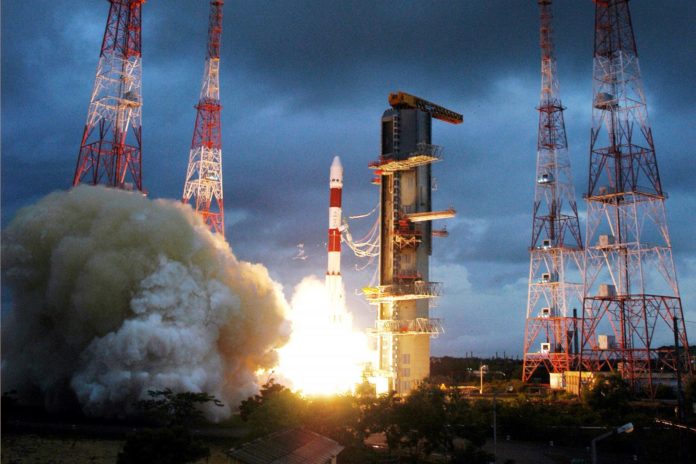PSLV-C34 Successfully takes off with 20 satellites from Satish Dhawan Space Centre to space;
Top 10 facts on Spotlight
Sky is the limit is a true scale for The Indian Space Research Organisation (ISRO) as on Wednesday they set a new record of launching 20 satellites, including India’s Cartosat-2 series and those the U.S., Germany, Canada and Indonesia successfully in to orbit.
Indian space agency ISRO today successfully placed in orbit a record 20 satellites carried by its flagship rocket in a 26-minute flight from Sriharikota in Andhra Pradesh.
At 9:26 a.m., ISRO’s workhorse PSLV C-34 lifted off from the Satish Dhawan Space Centre at Sriharikota,India.

Two cross sectional views of PSLVC34 payload. Photo: MIB
PSLV performs tricky experiments
The vehicle will not only put 20 satellites into the same orbit — the highest number of satellites to be put into orbit by a PSLV — but it will perform two tricky experiments of the same nature.
About fifty minutes after the satellites are placed into the orbit from the fourth stage of the PSLV, it’s engine will be re-ignited for five seconds. Again it will be shut down for 50 minutes and then re-ignited for another five seconds, according to K. Sivan, Director, Vikram Sarabhai Space Centre, Thiruvananthapuram.
Top facts to consider:
The 320 tonne PSLV C-34 carried 17 foreign small satellites from Canada, Indonesia, Germany and the US but the main passenger was a 727 kg Indian earth observation satellite called Cartosat, which can take images at sub-meter resolution.
The launch also placed into orbit two Indian academic community built satellites, Sathyabhamasat and Swayam.
ISRO also launched 13 US-made small satellites into space, which includes an earth imaging satellite made by Terra Bella, a Google-owned company. The 110 kg Google satellite called SkySat Gen- 2 is capable of taking sub-meter resolution images and high definition video.
On its 36th launch, the PSLV flew 20 satellites, weighing about 1288 kg, into space at a cost about half than other space agencies.
Cartosat-2 Series is similar to the earlier Cartosat-2, 2A and 2B, and 19 co-passenger satellites together weighing about 560 kg at lift-off would be injected into a 505-km polar Sun Synchronous Orbit.
With 20 satellites, the Indian space agency beat its previous record of placing 10 satellites in April 2008.
The rocket carried LAPAN A3 of Indonesia, BIROS of Germany, SKYSAT GEN 2-1 of US, MVV of Germany among the micro satellites, ISRO sources said.
With this launch, ISRO is ready to take on private billionaires like Elon Musk and Jeff Bezos who have entered the space launch business and offer far cheaper space launches.
Till now, ISRO has launched 57 satellites for foreign vendors from about 20 countries, earning about $ 100 million in the bargain.
Witnessed with immense pride and delight the brilliant moments on TV & took photos for my Instagram account. pic.twitter.com/lfGSkCUmjk
— Narendra Modi (@narendramodi) June 22, 2016
20 satellites in a go! @isro continues to break new barriers. Hearty congratulations to our scientists on the monumental accomplishment.
— Narendra Modi (@narendramodi) June 22, 2016
| » | India’s earth observation spacecraft Cartosat-2 Series satellite and 19 other satellites put together weighing about 560 kg at lift-off would be placed into a 505 km polar Sun Synchronous Orbit. |
| » | The primary satellite to be carried by PSLV C-34 rocket is similar to Cartosat-2, 2A and 2B satellites launched earlier. The imagery to be sent by the satellite would be useful for cartographic applications, coastal land use and regulation, utility management like road networking, water distribution, creation of land use maps, precision study, change detection to bring out geographical and manmade features and various other Land Information System and Geographical Information System applications. |
| » | SkySat Gen2-1 (U.S.): Designed and built by Terra Bella, a Google company based in Mountain View, California in the U.S., the small Earth imaging satellite is capable of capturing sub-meter resolution imagery and HD video. |
| » | M3MSat (Canada): Maritime Monitoring and Messaging Micro-Satellite is a technology demonstrator mission jointly funded and managed by Defense Research and Development Canada (DRDC) and the Canadian Space Agency (CSA). The satellite’s primary mission is to collect and study Automatic Identification System signals from low-Earth orbit. |
| » | GHGSat-D (Canada): Built by Space Flight Laboratory of the University of Toronto Institute for Aerospace Studies, the Earth observation satellite is meant for measuring the atmospheric concentration of greenhouse gases (Carbon Dioxide and Methane). |
| » | BIROS (Germany): Berlin Infrared Optical System (BIROS) is a small scientific satellite from the German Aerospace Center and its mission objective is the remote sensing of high temperature events. |
| » | LAPAN-A3 (Indonesia): The microsatellite is for Earth observation and is intended to be used to monitor land use, natural resource and environment. |
| » | Dove Satellites (U.S.): A total of 12 Flock-2P Earth imaging satellites are to be launched in this mission. They would be packed in three dispensers. |
| » | Sathyabamasat (Sathyabama University, Chennai): The satellite aims to collect data on green house gases. |
| » | Swayam (College of Engineering, Pune): The satellite aims to provide point to point messaging services to the HAM (amateur radio) community. |
Heartiest congratulations to ISRO Team on successful launch of PSLV-C34 carrying a record 20 satellites #PresidentMukherjee
— President Mukherjee (@POI13) June 22, 2016
#PSLVC34 carries LAPAN A3 of Indonesia, BIROS of Germany, SKYSAT GEN 2-1 of US, MVV of Germany among others pic.twitter.com/nspV2LMyhC
— EconomicTimes (@EconomicTimes) June 22, 2016
#ISRO: We have accomplished a major landmark today.
Launch of #PSLVC34/#Cartosat– 2 from #Sriharikota pic.twitter.com/X3J3cdcxA8— Doordarshan National (@DDNational) June 22, 2016
Scaling new hights! #ISRO launches PSLV-C34 carrying 20 satellites: 10 key facts to know https://t.co/Gu20YK2X3b pic.twitter.com/pLwY196Hdq
— Business Today (@BT_India) June 22, 2016
PSLV rocket launch photo credit ISRO




















